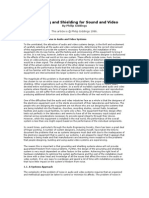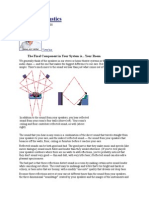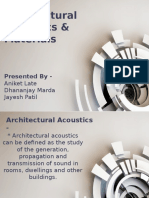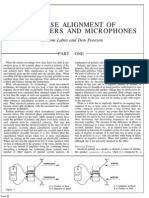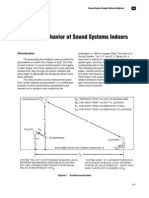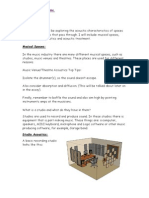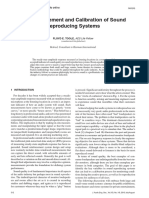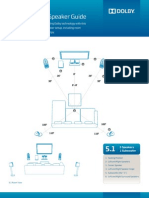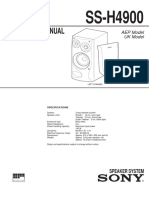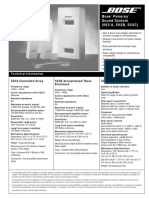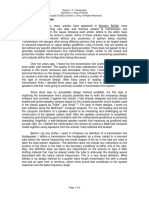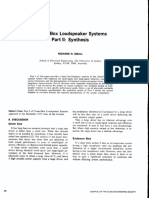Audio Spotlighting New
Audio Spotlighting New
Uploaded by
Anil DsouzaCopyright:
Available Formats
Audio Spotlighting New
Audio Spotlighting New
Uploaded by
Anil DsouzaOriginal Description:
Copyright
Available Formats
Share this document
Did you find this document useful?
Is this content inappropriate?
Copyright:
Available Formats
Audio Spotlighting New
Audio Spotlighting New
Uploaded by
Anil DsouzaCopyright:
Available Formats
AUDIO SPOTLIGHTING
1. INTRODUCTION
Hi-fi speakers range from piezoelectric tweeters to various kinds of mid-range speakers and woofers which generally rely on circuits and large enclosures to produce quality sound, whether it dynamic, electrostatic or some other transducer based design. Engineers have struggled for nearly a century to produce a speaker design with the ideal 20Hz to 20,000Hz capability of human hearing. When you listen to sound over loudspeakers, you dont have any control over where the sound goes. Sometime s you don't want it to go everywhere. Scientists have devised a way to solve that problem. They have figured out how to steer sounds by aiming them only where he wants them to go with a device they call Audio Spotlight.
Audio spot lighting is a technology that creates focused beams of sound similar to light beams coming out of a flash light. By shining sound to one location, Specific Listeners can be targeted with sound without others nearby hearing it, i.e. to focus the sound into a coherent and highly directional beam. It makes use of non-linearity property of air.
Imagine projecting sound in a narrow beam, much like the light from a spotlight! In the past we were limited by sound invading all of the space surrounding the loudspeaker or sound source. Not anymore! With the Audio spotlighting Sound systems, you can put sound wherever you want. With a spotlight, when you step into the beam of light, you are clearly illuminated by the light. When you step out of the beam, you are lit only by the background light. Similarly you can't see the beam of sound, but when you step into it, you can hear the sound or narration inside! Step back out of the beam and the sound is gone! Stepping into the directional sound beam is like putting on a set of virtual headphones. You can now have several different soundtracks or musical styles co-exist in one small space, heard only by those who should.
The Audio spotlight developed by American Technology Corporation uses ultrasonic energy to create extremely narrow beams of sound that behaves like beam of light. Audio spotlight exploits the property of non-linearity of air. When in audible Dept. of E&C 1 BIT, MANGALORE
AUDIO SPOTLIGHTING
ultrasonic pulses are fired into the air, it spontaneously converts the inaudible ultrasound into an audible sound. A device known as parametric array employs the non-linearity of the air to create audible by products from inaudible ultrasound, resulting in extremely directive and beam like sound. This source can projected about an area much like a spotlight and creates an actual specialized sound distant from a transducer. The ultrasound column acts as a airborne speaker, and as the beam moves through the air gradual distortion takes place in a predictable way. This gives rise to audible components that can be accurately predicted and precisely controlled.
Sound from ultrasound is the name given here to situations when modulated ultrasound can make its carried signal audible, without needing a receiver set. This happens when the modulated ultrasound passes through anything which behaves nonlinearly and thus acts intentionally or unintentionally as a demodulator.
Also, problems with creating low bass tones will keep Audio spotlighting systems out of Audio philes for the present. On the other hand, this is not preventing Sony from incorporating the technology in plasma screens for specialty applications. Widespread application of Audio spotlighting could still be years away, but with companies like Sony interested, it can only speed mainstream adoption of the technology.
Dept. of E&C
BIT, MANGALORE
AUDIO SPOTLIGHTING
2.HISTORY
History is replete with rival inventors battling one another to bring breakthrough creations to market. Howe and Singer over the sewing machine, Bell and Gray over the telephone, Edison and Swan over the light bulb.
Now, in that same tradition, two inventors Elwood Woody Norris of Poway, CA based American Technology Corporation (ATC), and F. Joseph Pompei, of Watertown, MAs Holosonic Research Labs, have harnessed the same scientific principle to create competing directional-sound systems.
The technique of using a nonlinear interaction of high-frequency waves to generate low-frequency waves was originally pioneered by researchers developing underwater sonar techniques dating back to the 1960s. They called this device a parametric array. In 1975, an article cited the nonlinear effects occurring in air.
Over the next two decades, several large companies, including Matsushita, NC Denon, and Ricoh attempted to develop a loudspeaker based on this principle. They were successful in producing some sort of sound, with extremely high levels of distortion (>50).
Later during the spring of 1996, Elwood Woody Norris one of the founders of American Technology Corporation was working blind to his competitor in the East within his garage in Poway CA. He felt that ultrasound could be used to create a sound beam. In July the same year, he felt that he had a breakthrough and he rushed off to the patent office, and patented the same.
In 1998, Joseph Pompei presented the paper The Use of Airborne Ultrasonic for generating Audible Sound Beams to the Audio Engineering Society, at their 105th Convention in san Francisco CA. In 1999 he founded holosonic Research Labs or Holosonics to commercialize this technology. He named it Audio spotlighting.
Dept. of E&C
BIT, MANGALORE
AUDIO SPOTLIGHTING
Figure 2.1: FJOSEPH POMPEI at the MIT lab .propagation of sound from audio spotlighting device.
Dept. of E&C
BIT, MANGALORE
AUDIO SPOTLIGHTING
3. TECHNOLOGY OVERVIEW
The technique of using a nonlinear interaction of high frequency waves to generate low frequency waves was originally pioneered by researchers developing underwater sonar techniques in 1960s. In 1975, an article cited the nonlinear effects occurring in air. Over the next two decades, several large companies including Panasonic and Ricoh attempted to develop a loudspeaker using this principle. They were successful in producing some sort of sound but with higher level of distortion (>50 percent). In 1990s, Woody Norrisa Radar Technician solved the parametric problems of this technology.
Audio spotlighting is a paradigm shift in sound production based on solid principles of physics. Audio spotlighting technology projects a column of modulated ultrasonic frequencies in to the air. These ultrasonic frequencies are inaudible by themselves. However ,the interaction of the air and modulated ultrasonic frequencies creates audible sounds that can be heard along a column. This audible acoustical sound wave is caused when the air down-converts the ultrasonic frequencies to the lower frequency spectrum that humans can hear.
Audio spotlighting technology works by emitting harmless high frequency ultrasonic tones that we cannot here. These tones use the non-linearity (fig 3.1) property of air to create new tones that are within the range of human hearing. The result is an audible sound. The acoustical sound wave is created directly in the air.
In an Audio spotlighting system, there are no voice coils, cones, crossover networks or enclosures. The result is sound with a potential purity and fidelity which we attained never before. Sound quality is no longer tied to speaker size. The Audio spotlighting system holds the promise of replacing conventional speakers in homes, movie theatres, and automobiles everywhere.
Dept. of E&C
BIT, MANGALORE
AUDIO SPOTLIGHTING
Figure 3.1: Non linear medium
Figure 3.2: Pressure v/s distance curve
At normal atmospheric pressure and a temperature of 20rC, a small audio signal travels through air at approximately 300m/sec. As the amplitude of the sound signal increases to more than approximately 100 dB, the speed of sound changes over the course of a single cycle. The upper part of the waveform sufficiently compresses air molecules to increase the local temperature and pressure and, therefore, slightly boost the speed of sound. Likewise, the negative portion of the waveform slows sound propagation. These speed variations result in a distorted waveform that resembles a triangular wave (fig3.2).Because triangular waves are rich in harmonics, the speed variations demodulate the ultrasound signal. The blue line in fig-3.2 is a pure sine wave, and the red represents the same form after it has propagated through the nonlinear air for a time. Dept. of E&C 6 BIT, MANGALORE
AUDIO SPOTLIGHTING
3.1 Conventional sound:
The regular loudspeakers produce audible sound by directly moving the air molecules. The audible portions of sound tend to spread out in all directions from the point of origin. They do not travel as narrow beams. In fact the beam angle of audible sound is very wide, just about 360 degrees. This effectively means that the sound you hear will be propagated through the air equally in all directions. Conventional loudspeakers suffer from amplitude distortions, harmonic distortion, inter modulation distortion, phase distortion, crossover distortion, cone resonance etc. Some aspects of their mechanical aspects are mass, magnetic structure, enclosure design and cone construction.
In nature, sound travels in waves spreading in every direction, bouncing of some surfaces and being absorbed by others. It is certainly not linear. It helps to visualize the traditional loudspeaker as a light bulb. As with the light bulb, a traditional loudspeaker radiates sound fairly uniformly in all directions. A listener can stand anywhere in an acoustical environment and point to the speaker as the source of the sound. Audio spotlighting technology is much more analogous to the beam of light from a flashlight .Figures 3.3 shows the conventional speakers distribution of sound and figure 3.4 shows the beam of sound targeted to particular place. If you stand to the side or behind the light, you can only "see" the light when it strikes a surface. Audio spotlighting technology is similar in that you can direct the ultrasonic emitter toward a hard surface, a wall for instance, and the listener perceives the sound as coming from the spot on the wall.
The listener does not perceive the sound as emanating from the face of the transducer but, only from the reflection of the wall. Every form of distortion contributed by a conventional loudspeaker is traceable to some aspect of its mechanical nature, mass, magnetic structure, enclosure design, cone construction, etc. All form an important part of the final product's capability to perform its function in as perfect a manner as possible.
Dept. of E&C
BIT, MANGALORE
AUDIO SPOTLIGHTING
Figure 3.3: conventional speakers.
Speaker cone motion is subject to the laws of physics. This all-important element ,more than any other in a speaker system, affects the overall purity of sound and can be a source of various forms of distortion. Ideally, when reproducing sound, the speaker cone should follow precisely the delicate nuances of any electrical waveform presented to it. The cone or radiating surface of a perfect loudspeaker would have virtually no mass or resonances over the entire range of hearing, and would offer perfect linearity while at the same time being able to couple enough energy into the air to produce any sound level desired.
Audio spotlighting technology does precisely that. It provides linear frequency response with virtually none of the forms of distortion associated with conventional speakers. Physical size no longer defines fidelity. The faithful reproduction of sound is freed from bulky enclosures. There are no woofers, tweeters, crossovers, or bulky enclosures .Also, it is now possible to dramatically minimize room effects in a listening environment.
Dept. of E&C
BIT, MANGALORE
AUDIO SPOTLIGHTING
Figure 3.4: audio spotlighting.
3.2 Range of human hearing:
The human ear is sensitive to frequencies ranging from 20Hz to 20,000Hz. If the range of the human hearing is expressed as a percentage shift from the lowest audible frequency to the highest, it spans a range of 100,000 percent. No single loudspeaker element can operate efficiently over such a wide range of frequencies. In order to deal with this, speaker manufacturers carve the audio spectrum into smaller sections (fig3.5), and make use of multiple transducers and crossovers as necessary. They range from piezoelectric tweeters that recreate the high end of the audio spectrum, to various kinds of midrange speakers and woofers that produce the lower frequencies. Using a technique of multiplying audible frequencies upwards and superimposing them on a "carrier" of say,200,000 cycles the required frequency shift for a transducer would be only 10.
Whether they are dynamic, electrostatic, or some other transducer-based design, all loudspeakers today have one thing in common: they are direct radiating i.e., they are fundamentally a piston-like device designed to directly pump air molecules into motion to Create the audible sound waves we hear. Audio spotlighting technology produces sound in the air indirectly as a by-product of some other process. Using Audio spotlighting technology, it is possible to design nearly a perfect transducer.
Dept. of E&C
BIT, MANGALORE
AUDIO SPOTLIGHTING
Depending on the user requirements the bandwidth of Audio spotlighting unit can be adjusted. The red plot shows the normal usage. The blue plot is the Bass cut plot, where the lower frequencies are cut. This is very useful for speeches. The black plot is the Bass boost plot, where the lower frequencies are given importance. This is very useful for musical concerts.
Figure 3.5: audio spectrum.
3.3 Working of Audio spotlighting system:
The original low frequency sound wave such as human speech or music is applied into an audio spotlight emitter device. This low frequency signal is frequency modulated with ultrasonic frequencies range. The output of the modulator will be the modulated form of original sound wave. Since ultrasonic frequency is used the wavelength of the combined signal will be in the order of few millimeters. Since the wavelength is smaller the beam angle will be around 3 degree, as a result the sound beam will be a narrow one with a small dispersion. The model of spotlighting emitter is shown in figure3.7.
Dept. of E&C
10
BIT, MANGALORE
AUDIO SPOTLIGHTING
Figure 3.6: Plot of bass cut, bass boost and normal sound.
While the frequency modulated signal travels through the air, the nonlinearity property of air comes into action. A normal sound wave is a small pressure wave that travels through the air. As the pressure goes up and down, the nonlinear nature of the air itself lightly changes the sound wave. If there is change in a sound wave, new sounds are formed within the wave. Therefore if we know how the air affects the sound waves, we can predict exactly what new frequencies (sounds) will be added into the sound wave by the air itself. If the audio spectrum could be superimposed on this high frequency carrier, and emitted into the air as an ultrasonic acoustical wave front, the only thing remaining would be to down convert the ultrasonic energy to sonic energy we could hear. This ultrasonic sound wave (beyond the range of human hearing) can be sent in to the air with sufficient volume to cause the air to create the required new frequencies. Sincewe cannot here the ultrasonic sound, we only hear the new sounds that are formed by the non linear action of the air.
Dept. of E&C
11
BIT, MANGALORE
AUDIO SPOTLIGHTING
Figure 3.7: audio spotlight emitter.
Example: In order to generate a frequency (sound) of 1000Hz, we use ultrasonic waves of50,000Hz and 51,000Hz frequency. These frequencies, due to nonlinearity and also distortion produce 101,000Hz (inaudible) and 1000Hz (audible) which is the required frequency.51,000+50,000=101,000Hz 51,000-50,000=1000Hz
Thus in an audio spotlighting there are no actual speakers that produces the sound but the ultrasonic envelope acts as the airborne speaker. The directivity of the beam i.e, output of the system is shown in the figure-3.8.
Dept. of E&C
12
BIT, MANGALORE
AUDIO SPOTLIGHTING
Figure 3.8: Beam Directivity
The new sound produced virtually has no distortions associated with it and faithful reproduction of sound is feed from bulky enclosures. There are no woofers or crossovers. This technology is similar in that you can direct the ultrasonic emitter towards a hard surface, a wall for instance and the listener perceives the sound as coming from the spot on the wall. The listener does not perceive the sound as emanating from the face of the transducer, but only from the reflection of the wall. For the maximum volume (sound level) that trade show use demands, it is recommended that the audio spotlight speakers, more accurately called a transducer, is mounted no more than 3 meters from the average listeners ears, or 5 meters in the air the mounting hardware is constructed with a ball joint so that the audio spotlights are easily aimed wherever the sound is desired.
Figure 3.9: computer simulation of sound beam.
Dept. of E&C
13
BIT, MANGALORE
AUDIO SPOTLIGHTING
By creating a complex ultrasound waveform(using a parametric array of ultrasound sources)figure-3.9 shows computer simulation of sound propagation with complex sets, many different sources of sound can be created. If their phases are carefully controlled, then these interfere destructively laterally and constructively in the forward direction, resulting in a collimated sound beam or audio beam or audio spotlight. Today, the transducers required to produce these beams are just half an inch thick and lightweight, and the system required to drive it has similar power requirements to conventional amplifiers technology.
3.4 Beam Dispersion
Figure 3.10: Dispersion of sound beam
In general, the dispersion is less than 3 in either direction or a total of 6 overall(fig 3.10). Dispersion of the audio wave front can be tightly controlled by contouring the face of the audio spotlighting ultrasonic emitter. For example, a very narrow wave front might be developed for use on the two sides of a computer screen while a home theater system might require a broader wave front to envelop multiple listeners.
In addition, audio spotlight does not follow the traditional loudspeaker inversesquare law, which dictates that you have a 6dB decrease in level for every doubling of the
Dept. of E&C
14
BIT, MANGALORE
AUDIO SPOTLIGHTING
distance from the source. This fact means that Audio spotlight can travel much greater distances while maintaining intelligibility than the sound from conventional speakers.
3.5 Why Ultrasonic?
Directivity of the wave depends on its wavelength compared to the transmitting surface. The larger the source is compared to the wavelength of the sound waves, the more directional beam results. Assuming that HSS uses 48 kHz, following calculations couldbe made. The speed of sound is about 300 m/sec, or 30,000 cm/sec. Speed = (wavelength)*(frequency) => Wavelength=speed/frequency i.e., 30,000/48,000 = 0.63 cm.
Normally, the emitter's frontal area is 28 cm x 28 cm, or approx 44 wavelengths square. This fact is the basic source of the device's tight directionality. When an emitter's size approximates the wavelength of the emitted signal, a spherical wave front is produced (fig 3.12a), which expands with a surface area proportional to the square of the distance from the emitter; thus producing inverse-square dispersal of energy across the expanding surface.
Figure 3.11: Types of ultrasonic emitters
Dept. of E&C
15
BIT, MANGALORE
AUDIO SPOTLIGHTING
A frequency of 1000Hz, for instance, yields a wavelength of 30 cm or about one foot. Thus a signal in this frequency range, produced by a normal speaker whose diameter might be approximately one foot, will produce a spherical wave front. However when the wavelength is a small fraction of the size of the emitter, an essentially flat wave front is produced (fig 3.11b). If it were truly flat and constrained to a channel, such a signal would lose strength only due to interactions with the channel, and could travel very long distances. Since our Audio spotlight beam is not in a channel, it will lose some energy to adjacent air. The ultrasound, whose wavelengths are only a few millimeters long, are much smaller than the source, and consequently tend to travel in a straight line. Of course, this ultrasound, which contains frequencies far outside our range of hearing, is completely inaudible. But as the ultrasonic beam travels through the air, the inherent properties of the air cause the ultrasound to distort (change shape) in a predictable way. This distortion gives rise to frequency components in the audible bandwidth. By generating the correct ultrasonic signal, we can create, within the air itself, essentially any sound desired.
Both audible sound waves from traditional speakers and ultrasound waves from a directional-sound system distort when they travel through the air. But, in a traditional sound system, the distortion slightly degrades the sound a listener ultimately hears. But in a directional-sound system, the distortion is actually the mechanism that generates the audible sound, breaking the ultrasound waves into lower-frequency, audible sound waves along a straight, narrow path. When the waves encounter a solid object or person ,they slow, distort and crash together. The result is the ultrasonic waves re-create the original sound in the air around the object, so humans can hear it. Variations in the speed of sound cause this phenomenon. Thus, sound from a distant Audio spotlight speaker seems like its right at your ears because it is actually being created right at your ears. If you step out of the beam, the waves have nothing to distort and mix them, so the inaudible ultrasonic waves slide silently past. Where, p2(x,t)=Audible secondary pressure wave
Figure 3.12: Equation Dept. of E&C 16 BIT, MANGALORE
AUDIO SPOTLIGHTING
K = physical parameter Pc=Pressure of ultrasonic carrier. E(x,t)=Envelope function (DSB) Previous equation says that the audible demodulated ultrasonic pressure wave (output signal) is proportional to the twice differentiated, squared version of the envelope function (input signal).
3.6 COMPONENTS OF AUDIO SPOTLIGHTING SYSTEM:
1. Power Supply. 2. Frequency oscillator. 3. Modulator. 4. Audio signal processor. 5. Microcontroller. 6. Ultrasonic amplifier. 7. Transducer.
3.6.1 Power Supply:
Like all electronic systems, the audio spotlighting system works on DC Voltage, ultrasonic amplifier requires 48v for its working and low voltage. For microcontroller and other processing unit management.
3.6.2 Frequency oscillator:
The frequency oscillator generates ultrasonic frequency signals in the range of (21,000Hz to 28,000 Hz) which is required for the modulation of information signals.
Dept. of E&C
17
BIT, MANGALORE
AUDIO SPOTLIGHTING
Figure 3.13: Block Diagram of An Audio Spotlighting System.
3.6.3 Modulator:
In order to convert the source program material into ultrasonic signals, a modulation scheme is required. In addition, error correction is needed to reduce distortion without loss of efficiency. The goal, of course, is to produce audio in the most efficient manner while maintaining acceptably low distortion levels.
A DSB scheme is straightforward way to generate the required ultrasonic frequencies for a given base band signal. From the basic principles of the Fourier analysis, multiplication in the time domain is analogous to convolution in the frequency domain. Convolution between a baseband signal and a carrier frequency effectively images the base band signal around both sides of the carrier frequency spectral Dept. of E&C 18 BIT, MANGALORE
AUDIO SPOTLIGHTING
component, as shown in Fig3.8. We know that for a DSB system, the modulation index can be reduced to decrease distortion, because total harmonic distortion increases proportionally with the square of m. This is because as the side bands gain more power, there is more cross interference between the side bands rather than between the side bands and the carrier frequency component.
3.6.4 Microcontroller:
A dedicated microcontroller circuit takes care of the functional management of the system. In the future version, it is expected that the whole process like functional management, signal processing, double side band modulation and even switch mode power supply would be effectively taken care of by a single embedded IC.
Figure 3.14: DSB Signal Representation
3.6.5 Audio signal processor:
The audio signal is sent to an electronic signal processor circuit where equalization, dynamic range control, distortion control and precise modulation are performed to produce a composite ultrasonic waveform. This amplified ultrasonic signal is sent to the emitter, which produces a column of ultrasonic sound that is subsequently converted into highly directional audible sound within the air column.
Dept. of E&C
19
BIT, MANGALORE
AUDIO SPOTLIGHTING
Since ultrasound is highly directional, the audio sound placement is precise. At the heart of the system is a high precision oscillator in the ultrasonic region with a variable frequency ranging from 40 to 50 kHz.
3.6.6 Ultrasonic Amplifier:
High efficiency ultrasonic power amplifiers amplify the management of the system. In the future version, it is expected that the whole process like functional management, signal processing, double side band modulation and even switch mode power supply would be effectively taken care of by a single embedded IC.
3.6.7 Transducer:
The most active piezo film is polyvinalidene difluoride. This film is commonly used in many industrial and chemical applications.
In order to be useful for ultrasonic transduction, the raw film must be polarized or activated. This is done by one of the two methods. One method yields a uniaxial film that changes length along one axis when an electric field is applied through it. The other method yields a biaxial film that shrinks/expands along two axes. Finally, the film needs to have a conductive electrode material applied to both sides in order to achieve a uniform electric field through it.
Piezoelectric films operate as transducers through the expansion and contraction of X and/or Y axes of the film surface. For use as a hypersonic sound emitter, the film is to be curved or distended. The curving results in expansion and contraction in the Z axis, generating acoustic output.
The music or voice from the audio source is converted into a highly complex ultrasonic signal by the signal processor before being amplified and emitted into the air by the transducer. Since the ultrasonic energy is highly directional, it forms a virtual column of sound directly in front of the emitter, much like the light from a flash light.
Dept. of E&C
20
BIT, MANGALORE
AUDIO SPOTLIGHTING
Figure 3.15: Piezo sound emitter
Fig 3.15 shows the structure of piezo sound emitter. When a voltage is applied across the pins, the red element gets longer while the blue one shortens, causing a bend in the piezo. When the polarity changes, the opposite bend occurs. The maximum displacement change is in the center of the element where the cone is attached.
The latest ATC parametric sound generator is a monolithic, thin film structure that maintains coherent amplitude and phase across the entire device in a package measuring less than a half-inch thick . Because the emitter is larger than the wavelength of the frequencies involved, it emits the ultrasound wave as a pure plane wave with virtually no expansion in the beam diameter with distance.
Figure 3.16: Parametric Loudspeaker, Amazing Audio Spotlight.
Dept. of E&C
21
BIT, MANGALORE
AUDIO SPOTLIGHTING
It is 1.27 cm thick and 17 inch in diameter. It is capable of producing audibility up to200 meters with better clarity of sound. It has the ability of real time sound reproduction with zero lag. It can be wall, overhead or flush mounted. These transducers are arranged in form of an array called parametric array in order to propagate the ultrasonic signals from the emitter and thereby to exploit the nonlinearity properly of air.
Dept. of E&C
22
BIT, MANGALORE
AUDIO SPOTLIGHTING
4.MODES OF LISTENING
There are two modes of listening: 1. Direct Mode. 2. Projected Mode.
Figure 4.1: directed audio and projected audio
4.1 Direct Mode
Direct mode requires a clear line of approach from the sound system unit to the point where the listener can hear the audio. To restrict the audio in a specific area this method is appropriate. This method is appropriate when we want to restrict the audio in a specific area .Fig 4.1 shows the concept of direct mode.
4.2 Projected or Virtual mode:
This mode requires an unbroken line of approach from the emitter of audio spotlighting system, so the emitter is pointed at the spot where the is to be heard. For this mode of operation the sound beam from an emitter is made to reflect from a reflecting surface such as a wall surface or a diffuser surface. A virtual sound source creates an illusion of sound source that emanates from a surface or direction where no physical loudspeaker is present. This method is appropriate when we want to send the information to a large number of people. Fig 4.1 shows the concept of virtual mode.
Dept. of E&C
23
BIT, MANGALORE
AUDIO SPOTLIGHTING
5. ADVANTAGES AND DISADVANTAGES
5.1 ADVANTAGES: i. Small size:
Audio spotlighting not only has the conventional speaker's crossover network and enclosure been eliminated, but the ultra-small radiating ultrasonic emitter is so small and light-weight that the inertial considerations ordinarily associated with traditional direct radiation speakers are virtually non-existent. The voice coil and support structure normally associated with the conventional speaker used to attach the moving cone in place are eliminated.
ii.
Single source:
Audio spotlighting has the ability to produce nearly the entire audible spectrum of frequencies from a single source. Hence the improvement in phase response, time alignment, and frequency response becomes obvious.
iii.
Ultimate control in audio placement/Highly directional:
Audio spotlight can focus sound only at the place where we want it. This is achieved by controlling the dispersion of the wave. These focused sound travels much farther in a straight line than conventional counterpart.
iv.
Minimizes noise pollution:
Audio spotlight reduces the unnecessary noise from public functions or gatherings.
v.
Ease of installation:
Audio spotlight reduces the unnecessary noise from public functions or gatherings.
vi.
5.6 Lowest maintenance cost:
Since Audio spotlight system has no mechanical, and very few electrical components, the maintaining cost very less.
Dept. of E&C
24
BIT, MANGALORE
AUDIO SPOTLIGHTING
vii.
Reduced feedback:
As Audio spotlight systems allow us to direct the produced audio away from any live microphone, the tendency of feedback is significantly reduced.
viii.
There is no need to worry about pets:
Dogs and cats can hear sounds up to perhaps 40,000 Hz, and Audio spotlight system operates well above this range.
5.2 DISADVANTAGES:
i.
Lack of mass production i.e, each unit must be handmade.
ii.
The most common form of distortion is clipping. An LED on top of the Audio spotlight system reports clipping, which is also perceptible to the listener as a kind of a 'chirping' effect. If any signal produces distortion, the input level of the source is reduced until perceptible distortion is eliminated.
Dept. of E&C
25
BIT, MANGALORE
AUDIO SPOTLIGHTING
6. APPLICATIONS
6.1 Automobiles:
Beam alert signals can be directly propagated from an announcement device in the dashboard to the driver. Presently Mercedes Benz buses are fitted with audio spotlighting speakers so that individual travelers can enjoy the music of there on interest.
Figure 6.1: Benz car
6.2 Retail sales:
Provide targeted advertising directly at the point of purchase.
Figure 6.2: A retail shop
6.3 Safety Officials:
Portable audio spotlighting devices for communicating with a specific person in a crowd of people.
6.4 Public Announcement:
Highly focused announcement in noisy environments such as subways, airports, amusement parks, traffic intersections etc. By maintaining a beam of sound, across the traffic, traffic police can use audio spotlighting to help the blind people cross the road at the signals.
Dept. of E&C
26
BIT, MANGALORE
AUDIO SPOTLIGHTING
Figure 6.3: Public announcement
6.5 Entertainment Systems:
In home theatre system rear speakers can be eliminated by the implementation of audio spotlighting and the properties of sound can be improved.
Figure 6.4: Home theatre system
6.6 Museums:
In museums audio spotlight can be used to describe about a particular object to a person standing in front it, so that the other person standing in front of another object will not be able to hear the description.
Figure 6.5: Museum
6.7 Military Applications:
Ship to ship communications and shipboard announcements. And also it is used to misguide the enemy by creating the false shouting area away from the military camps.
Dept. of E&C
27
BIT, MANGALORE
AUDIO SPOTLIGHTING
6.8 Political:
With the help of HSS international gatherings, such as the United Nations, SAARC summit could have translated speech beamed directly to individuals: Spanish at one seat, Hindi at the other and Arabic at the next. All this without interference or individual earphones.
Dept. of E&C
28
BIT, MANGALORE
AUDIO SPOTLIGHTING
7.CONCLUSION AND ENHANCEMENTS
Being the most radical technological development in acoustics since the coil loudspeaker was invented in 1925... The audio spotlight will force people to rethink their relationship with sound. Audio spotlighting is going to make a revolution in sound transmission and the user can decide the path in which audio signal should propagate. Due to the unidirectional propagation its finds applications in large number of fields. The main intention of Audio spotlighting system is to reduce the unnecessary sound and to promote peace and quiet environment. With the companies like Sony and Bose interested, it is going to shape the future of sound and will serve our ears with magical experience.
The audio spotlighting holds the promise of replacing conventional speakers. Ultrasonic emitters have super high impedance, which allows low current in power amplifiers making them lighter. The future developments of this technology include a full functioning embedded system, including modulation, audio processing and distortion control.
Dept. of E&C
29
BIT, MANGALORE
AUDIO SPOTLIGHTING
Dept. of E&C
30
BIT, MANGALORE
You might also like
- RA The Book Vol 1: The Recording Architecture Book of Studio DesignFrom EverandRA The Book Vol 1: The Recording Architecture Book of Studio DesignNo ratings yet
- Acoustics of Small Rooms - Mendel Kleiner & Jiri TichyDocument11 pagesAcoustics of Small Rooms - Mendel Kleiner & Jiri Tichymach20_aardvark8064No ratings yet
- Creating A Simple Electroacoustic Piece in Easy Stages - 1Document6 pagesCreating A Simple Electroacoustic Piece in Easy Stages - 1repositoriopopularNo ratings yet
- David Dunn: Microphones, Hydrophones, Vibration Transducers: Rolling Your OwnDocument13 pagesDavid Dunn: Microphones, Hydrophones, Vibration Transducers: Rolling Your OwndylanNo ratings yet
- Shoe Box Vs VineyardDocument8 pagesShoe Box Vs VineyardAndrea VoiculescuNo ratings yet
- Ounding and Shielding For Sound and Video PDFDocument37 pagesOunding and Shielding For Sound and Video PDFMoyGar2014No ratings yet
- Looking Over My ShoulderDocument53 pagesLooking Over My ShouldertemplercNo ratings yet
- DIY Bass TrapDocument22 pagesDIY Bass Trapdipling2No ratings yet
- Room Acoustics - Steve KindigDocument15 pagesRoom Acoustics - Steve Kindigsweeney.paraic100% (2)
- Beyma 2009 DesignsDocument22 pagesBeyma 2009 DesignsFernando CostaNo ratings yet
- Architectural AcousticsDocument22 pagesArchitectural AcousticsJayesh PatilNo ratings yet
- Sound ProductionDocument16 pagesSound Productionboniface murimiNo ratings yet
- The Carver Corporation Profile: Our Past, Products and PrinciplesDocument74 pagesThe Carver Corporation Profile: Our Past, Products and Principleskhawar mukhtarNo ratings yet
- Streaming Immersive Audio ContentDocument8 pagesStreaming Immersive Audio ContentCaio Cesar LouresNo ratings yet
- JBL Acoustic - Design Manual - 1Document58 pagesJBL Acoustic - Design Manual - 1alexmilar100% (2)
- Impulse Alignment of Loudspeakers and MicrophonesDocument14 pagesImpulse Alignment of Loudspeakers and MicrophonesyogimgurtNo ratings yet
- JBL Professional Sound System Design Manual - 1999 Edition (Pt.2)Document44 pagesJBL Professional Sound System Design Manual - 1999 Edition (Pt.2)Morris Alexander100% (1)
- Section FourDocument9 pagesSection FourKatie-Marie MorganNo ratings yet
- Room Acoustics: de Vera Institute of Technology Old Albay District, Legazpi City, AlbayDocument9 pagesRoom Acoustics: de Vera Institute of Technology Old Albay District, Legazpi City, AlbayEren YeagerNo ratings yet
- Addition Number Six The Con'-Stant Di-Rec-Tiv'I-Ty White Horn White PaperDocument4 pagesAddition Number Six The Con'-Stant Di-Rec-Tiv'I-Ty White Horn White Paperjosiasns5257No ratings yet
- Audio TerminologyDocument25 pagesAudio TerminologyKaylaNo ratings yet
- The Haas EffectDocument2 pagesThe Haas EffectIzzy BlaoNo ratings yet
- Room Acoustics: Bouncing AroundDocument45 pagesRoom Acoustics: Bouncing AroundmanigupthaNo ratings yet
- Granular BibliographyDocument5 pagesGranular BibliographyNuhg CutofdirectorNo ratings yet
- Processing Stereo Audio FilesDocument8 pagesProcessing Stereo Audio FilesSimona GavrilescuNo ratings yet
- Basic Acoustic Measurement Primer v2Document7 pagesBasic Acoustic Measurement Primer v2Gators JoustNo ratings yet
- Olson - Elements of Acoustical Engineering 1940Document368 pagesOlson - Elements of Acoustical Engineering 1940Corina MariaNo ratings yet
- A New Loudspeaker Technology - Parametric Acoustic ModellingDocument8 pagesA New Loudspeaker Technology - Parametric Acoustic ModellingJerans100% (1)
- Studio Desk Plans V2Document9 pagesStudio Desk Plans V2MIle MilicNo ratings yet
- RealTraps - Room Measuring SeriesDocument16 pagesRealTraps - Room Measuring SeriesstocazzostanisNo ratings yet
- Olson Direct Radiator Loudspeaker EnclosuresDocument5 pagesOlson Direct Radiator Loudspeaker Enclosureskorea12345fsfagvdsvNo ratings yet
- CoaxialDocument10 pagesCoaxialKyle Fletcher100% (1)
- Building AcousticsDocument11 pagesBuilding AcousticsSindhura Valluri100% (1)
- PDFDocument30 pagesPDFcosasdeangelNo ratings yet
- HD Recording and Sampling TipsDocument16 pagesHD Recording and Sampling TipsBrian NewtonNo ratings yet
- Studio Manual (2014)Document8 pagesStudio Manual (2014)James BatesNo ratings yet
- Dolby Home Theatre Speaker Guide 5.1 6 8Document4 pagesDolby Home Theatre Speaker Guide 5.1 6 8goudkampNo ratings yet
- Room Reflections MisunderstoodDocument17 pagesRoom Reflections MisunderstoodJeransNo ratings yet
- The Story of Stereo, John Sunier, 1960, 161 PagesDocument161 pagesThe Story of Stereo, John Sunier, 1960, 161 Pagescoffeecup44No ratings yet
- Interpreting Spinorama Charts PDFDocument25 pagesInterpreting Spinorama Charts PDFjorge etayoNo ratings yet
- Visualization and Analysis of Loudspeaker VibrationDocument2 pagesVisualization and Analysis of Loudspeaker VibrationvenkatTANo ratings yet
- What Is AmbisonicsDocument10 pagesWhat Is AmbisonicsSoham PawarNo ratings yet
- Unit 25 Sound RecordingDocument21 pagesUnit 25 Sound Recordingapi-480389176No ratings yet
- Motional Feedback On A Loudspeaker WooferDocument122 pagesMotional Feedback On A Loudspeaker WooferValk1902No ratings yet
- HistoryDocument37 pagesHistoryHarneet SinghNo ratings yet
- Stereo Recording Techniques eDocument1 pageStereo Recording Techniques eminettocNo ratings yet
- Understanding Microphone SensitivityDocument3 pagesUnderstanding Microphone SensitivityEric SkinnerNo ratings yet
- The Ambisonic Decoder Toolbox: Extensions For Partial Coverage Loudspeaker ArraysDocument36 pagesThe Ambisonic Decoder Toolbox: Extensions For Partial Coverage Loudspeaker ArraysAaron J. HellerNo ratings yet
- REW Average Measurements and Impulse Correction RePhaseDocument8 pagesREW Average Measurements and Impulse Correction RePhasestephane voillotNo ratings yet
- Schoeps - Catalogo 2010Document144 pagesSchoeps - Catalogo 2010frantic_59No ratings yet
- Lumen White Loudspeaker DesignDocument17 pagesLumen White Loudspeaker DesigncantusNo ratings yet
- BLH Design ArticleDocument16 pagesBLH Design ArticleDebajyoti GhoshNo ratings yet
- Tip #2: Microphone Polar PatternsDocument2 pagesTip #2: Microphone Polar PatternspcmundotNo ratings yet
- Dialnorm - Broadcaster Compliance With The Calm ActDocument3 pagesDialnorm - Broadcaster Compliance With The Calm ActMark BehmNo ratings yet
- 4311b ManualDocument4 pages4311b Manualvova1cleric198830No ratings yet
- Product Handbook Arendal 1723 Series SubwoofersDocument56 pagesProduct Handbook Arendal 1723 Series SubwoofersDomagoj KovacevicNo ratings yet
- Owner S Manual BedienungsanleitungDocument16 pagesOwner S Manual BedienungsanleitungDaniel SfichiNo ratings yet
- JBL Control One ServiceDocument2 pagesJBL Control One ServiceVasco MelloNo ratings yet
- XOVER-3 Instr ManualDocument11 pagesXOVER-3 Instr ManualYuda AditamaNo ratings yet
- KS Series: User ManualDocument23 pagesKS Series: User ManualbachstradNo ratings yet
- Introduction To Loudspeakers and EnclosuresDocument84 pagesIntroduction To Loudspeakers and Enclosuresatom777100% (1)
- Equipo Sony SS-H4900 Service ManualDocument2 pagesEquipo Sony SS-H4900 Service ManualluissanchezmNo ratings yet
- ISA-RP52.1-1975 - Recommended Enviroments For Standards LaboratoriesDocument32 pagesISA-RP52.1-1975 - Recommended Enviroments For Standards LaboratoriesJorge Cota AcostaNo ratings yet
- Beta-12Lta: American Standard SeriesDocument2 pagesBeta-12Lta: American Standard SerieschannelmksNo ratings yet
- FE103 enDocument2 pagesFE103 en1TubeNo ratings yet
- Quad 22L Speaker: Tallest of A New Series, This Floorstander Looks The BusinessDocument2 pagesQuad 22L Speaker: Tallest of A New Series, This Floorstander Looks The BusinessMatimba SimangoNo ratings yet
- Series: Automotive SubwoofersDocument4 pagesSeries: Automotive SubwoofersMauleonNo ratings yet
- FT - BF Slim 120Document2 pagesFT - BF Slim 120Luis Eduardo Champi sullcaNo ratings yet
- Harman Group - Loudspeakers and Rooms For Multichannel Audio Reproduction (Floyd E. Toole)Document74 pagesHarman Group - Loudspeakers and Rooms For Multichannel Audio Reproduction (Floyd E. Toole)andreslazarilloNo ratings yet
- Ficha Técnica Altavoces Bose 502ADocument4 pagesFicha Técnica Altavoces Bose 502AComendatore AsorataNo ratings yet
- Wharfedale SVP 12PMDocument13 pagesWharfedale SVP 12PMrdbasses100% (1)
- Pascal 2001Document11 pagesPascal 2001damonSteez7hotmail.comNo ratings yet
- V DOSC ManualDocument158 pagesV DOSC ManualValter Pereira da SilvaNo ratings yet
- Martin J. King - Section 1.0 - IntroductionDocument5 pagesMartin J. King - Section 1.0 - IntroductionDouglasNo ratings yet
- TOA 30 - 38sdDocument2 pagesTOA 30 - 38sdStephen_Pratt_868No ratings yet
- Profesional Sound Sistem - ToA 280-ME-AV (Made in Japan)Document2 pagesProfesional Sound Sistem - ToA 280-ME-AV (Made in Japan)Bogdan BvbNo ratings yet
- DSPPA DSP8062B Wall Mount SpeakerDocument4 pagesDSPPA DSP8062B Wall Mount SpeakervoninoserviceNo ratings yet
- Technical Specifications SB1000z: FeaturesDocument2 pagesTechnical Specifications SB1000z: FeaturesTC Sinan ÜzenliNo ratings yet
- Small - Closed Box System part-IIDocument8 pagesSmall - Closed Box System part-IIKichiro CarvajalNo ratings yet
- Hfe Mission Full Range 2006 enDocument40 pagesHfe Mission Full Range 2006 enandry100% (1)
- Kappa Pro-15A: Professional SeriesDocument2 pagesKappa Pro-15A: Professional SeriesSam PS100% (1)
- 8W3 ManDocument2 pages8W3 ManPaulina Robledo MorenoNo ratings yet
- DLS 12Document4 pagesDLS 12Brian PinillaNo ratings yet







